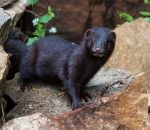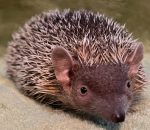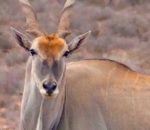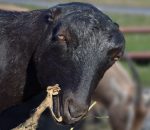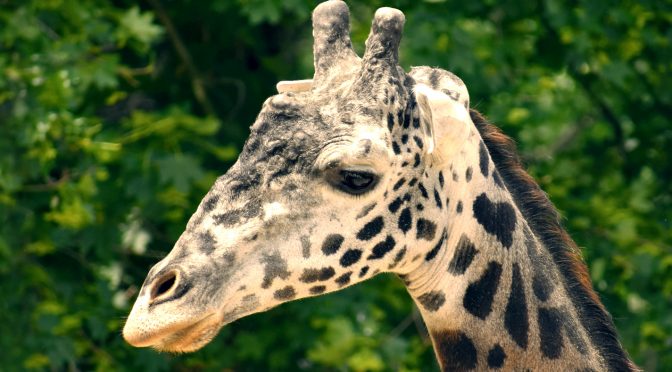NOTE: Education Animals are “behind-the-scenes” animals & only appear to the public during Educational events. This includes scheduled events or programs such as daily animal mingles, private onsite programs, and zoo reaches. For more information, please reach out to edureservations@lvzoo.org.
Program and General Information
Nine banded armadillos can be found in Northern Argentina through Southern United States and are the only species of armadillo found in the United States. They can get in length up to 2.5 feet long (from nose to tip of tail) and weigh up to 15 pounds. Males are generally larger than females. Nine-banded armadillos are blackish-brown to grey in coloration with yellowish white hair on its underside.
Armadillos are the only mammals covered by an outer body of armor made up of bony plates. Although named the “nine-banded”, these armadillos can have anywhere from 7-11 bands. Their primary diet consists of 75% insects and the other 25% consists of small reptiles, amphibians, and even plant matter (fruits, seeds, fungi). Breeding occurs once a year in the summer months. Gestation lasts 4 months after which the female will almost always give birth to 4 identical quadruplets. The young will nurse up to 60 days before the mother weans it, however, they young may remain with the mother for several months. They are considered mature at 1 year.
Diet
Nine-banded armadillos are generalist feeders and use their sense of smell to track down almost 500 different foods, most of which are invertebrates. Insects make up 75% of an armadillo’s diet, while the other 25% consists of of small reptiles, amphibians, and even plant matter (fruits, seeds, fungi).
Their sense of smell is their best sense, being able to smell invertebrates that are 8 inches below the surface. They can even stand on their hind legs to get a better vantage point for smelling. The armadillos’ long, curved claws help them to dig up prey, and like most insect eating mammals, their tongues are very long and sticky to slurp up insects quickly. The wiry hairs on an armadillo’s sides and belly, similar to “curb feelers” on a car, can help it sense prey underneath it.
Nine-banded armadillos are nocturnal and spend their waking time burrowing or feeding.
Habitat and Range
The nine-banded armadillo is the most widespread armadillo species, and the only armadillo native to the United States. Their range covers Southern North America through Argentina.
These armadillos prefer warm, wet climates and live in forested, grassland, wetland, and woodland habitats. Small streams are no obstacle for these amazing animals. The nine-banded armadillo can hold its breath for up to six minutes and can swim or “walk” along the bottom of rivers.
Common Physical Features
Nine-banded armadillos are a medium sized armadillo reaching lengths of 2.5 feet and weighing up to 15 pounds. Armadillos are the only mammals covered by an outer body of armor. Although called the nine banded, these armadillos can have anywhere from 7-11 bands. They are blackish-brown to grey in coloration with yellowish white hair on its underside. Males tend to be bigger than females. Their limbs are short with four toes on the front feet and five toes on the back feet. All digits have strong claws, however, the middle digits having the longest claws. These claws are very powerful and are used to dig to find insects.
Adaptations: The armadillo’s “armor” or carapace is made out of tough leathery skin and dermal plates (called osteoderms) which are divided into three sections: a scapular shield, a pelvic shield, and a series “bands” around the mid-section.
The dermal plates provide a tough yet flexible covering accounting for 16% of the armadillo’s total body weight. The armadillo’s head is also covered in keratinous scales, the same material that makes up our fingernails and hair, but their ears and underside lack any protective armor.
They have a long and tapered snout used to project their tongues in and out in order to forage for insects. Like most insect eating mammals, their tongues are very long and sticky to slurp up insects quickly. Insects are captured by digging up underground nests and/or tearing the bark off of rotting trees and turning over rotting leaf piles. Armadillos also have wiry hairs on their sides and bellies that act like feelers to help the armadillos sense any prey beneath them.
Unlike the three-banded armadillo that can actually rolls up in a ball for protection, the nine-banded armadillos, along with the other 18 species, must run, dig or press themselves in the dirt to keep from getting flipped over when threatened.
The nine-banded armadillos’ abandoned burrows are utilized by other animals, such as pine snakes, rabbits, opossums, mink, cotton rats, striped skunks, burrowing owls, and eastern indigo snakes.
Behavior and Life Cycle
Armadillos will often be solitary, only getting together in order to breed. Breeding occurs once a year in the summer months, and mature adults will breed every year for the rest of their life. Once breeding is successful, the gestation period lasts about 4 months, after which the female will almost always give birth to 4 identical young.
Right at birth their eyes are open and within a few hours they are up and walking around. At birth, the carapace of the offspring has not yet hardened and the unprotected young are extremely vulnerable to predation.
The young will nurse up to 60 days before the mother weans it, however, they young may remain with the mother for several months. Young armadillos are considered mature at one year. A baby armadillo is called a pup!
Conservation Messaging
Together with Nature
While not currently threated, nine-banded armadillos are are considered to be pests by many since they will burrow and destroy crops in order to eat insects.
This has led to many armadillos being killed by farmers and gardeners. They also can fall victim to cars. Nine-banded armadillos have a tendency to jump straight up into the air when they are startled, which often leads to their demise on highways. They are small enough that cars can pass right over them, but they leap up and hit the undercarriage of vehicles. And in some places, armadillos are even killed for their shell and eaten.
What can we do?: Although they are considered pests by some, armadillos are an important predator to many insect agricultural pests. In addition, these mammals are used for many medical research for leprosy due to their low body temperature to host the disease. Planting natural areas around your house or community encourages wildlife into the area by providing food and shelter for those species and can help keep them away from important crops.
Never remove an animal from the wild! Some well-meaning people will trap and relocate “pest” animals but the truth is, trapping rarely ends well for wildlife and is not a long term solution. While you might be thinking you are helping that animal, most people don’t realize the amount of care and time that goes in to caring for these animals, and removing them from their natural environment can be detrimental to the wild populations. If wild animals are not causing damage or posing danger, the best solution is to coexist! If you come across injured wildlife please call your local wildlife rehabilitation center as they are better equipped to handle and care for that animal.
The most important thing that we can do to help sustain their habitats is to “Leave No Trace”. Once you leave nature, no one should know that you’ve been there. This means bringing out anything that you’ve brought in. Additionally, leaving the environment unaltered is equally important.
Fun Facts
- Armadillo means “little armored one” in Spanish. They are closely related to sloths and anteaters.
- Armadillos’ teeth are single-rooted and peglike, ranging from 30-32 teeth. Armadillos are excellent swimmers because they can hold large amounts of air in their digestive tracts.
- Armadillos will switch their activity level based on the season. In the summer, they are more active during the cooler nights whereas the winter they are more active during the warmest time of the day.
- Their shell is considered to be modified skin (unlike a turtle who’s shell is made of bone) and has small hairs on its plates.
- The largest armadillo species, the giant armadillo, can get up to 5 feet!
Bibliography
